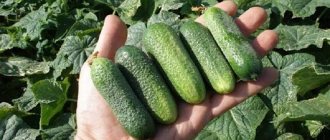Vegetable growing » Eggplant
0
1110
Article rating
Kira Stoletova
Eggplant Universal comes from Southeast Asia, so it loves hot climates. Today, more and more gardeners are growing this perennial plant.
Characteristics of eggplant variety Universal 6
Features and characteristics
Station wagon 6 was launched in the Volgograd region . It has been in the State Register of the Russian Federation since 1966. Next, you can read the description and characteristics of the Universal 6 variety and find out why the variety is considered universal.
Description
The bushes are compact, not spreading, 70-90 centimeters high, 55-65 cm in diameter. There are not many leaves, they are of medium size, ovoid-pointed in shape.
The length of the leaf blade is 22.0 - 22.4 cm, width - 11.0 -12.5 cm. The color is green, the edges are weakly rugged. There are no thorns, or they are very rare. The flowers are large and purple. The petals are acute-angled, the stamens are yellow. The fruits are cylindrical in shape . The size is not large - up to 19.5 cm in length. Weight – 120 – 175 grams. The skin is glossy, smooth to the touch. At technical maturity, the fruit is purple, but at biological maturity, the color becomes brownish-yellow.
Universal 6 mid-early variety. Technical ripening of fruits occurs 120–130 days after germination. Eggplants have a pleasant taste, without bitterness. The pulp is yellow-white, loose.
You can buy seeds of this variety once, and then grow several fruits to biological maturity and get your own.
Where is it grown?
The variety is suitable for open ground . They are grown in two regions: the North Caucasus and the Lower Volga. To expand sales of seeds in bags, they began to add information that this variety can be grown in a greenhouse.
Don't forget that Universal 6 is a variety, not a hybrid. Therefore, it needs flower pollination. Because of this, it will be difficult to get a large harvest in a greenhouse. We talked about the varieties most suitable for greenhouses here.
Varietal features and disadvantages
This variety has the following features::
- There are practically no thorns on the calyx, which makes harvesting easier.
- Resistance to some diseases that cause bushes to wilt.
- Resistance to high temperatures is noted; even in very hot weather, the plant continues to grow and bear fruit.
- Excellent taste characteristics of the fruit and good transportability.
There are some disadvantages:
- The variety does not tolerate low temperatures. So at +15 the plant stops growing, and at +10 it dies.
- Universal 6 is less productive than hybrids.
Description of the variety
To enjoy the taste of the fruit every year, it is enough to purchase Universal 6 eggplant seeds once. Then, for subsequent seasons, harvest the seeds yourself. To do this, one fruit must reach biological maturity - a brownish-yellow shade of the peel.
Description:
- fruit length is 18-20 centimeters. Diameter – 5-6 centimeters. Weight – up to 180 g;
- under favorable conditions, a harvest weighing 6.5 kilograms is obtained per square meter. In cool summers - about 3 kilograms;
- technical maturity occurs in 125-130 days;
- suitable for canning;
- the pulp is white, with a large number of small seeds;
- fruits without bitterness.
Growing
The variety is grown through seedlings . There are some features of this cultivation of the Universal 6 variety.
Landing dates
If the bushes are planted in open ground in early May, then the seeds need to be sown 2 months in advance and add a week for germination. In addition, each pick slows growth by 7 days. For sowing, take soil from the ground, compost and peat. There are other options, the main thing is that the soil is nutritious. But it’s easier to buy ready-made in the store.
- First, the seeds are planted in a container or box.
- Then fill it with earth and pour boiling water over it to disinfect it. If the seeds are not processed by the manufacturer, or they are prepared independently, then they need to be disinfected. To do this, keep them for 5 minutes in hot water (50 degrees) and 20 minutes in a solution of potassium permanganate (2 g per 2 liters of water). Then rinse with running water and dry.
- You need to plant at a depth of 1 -1.5 cm, a distance of 3-4 cm from each other.
Attention! Eggplants have a very delicate root system; try to grow them with a minimum number of transplants. - For seed germination, keep the temperature within +25 ..+27 degrees. After 7 days, the first shoots appear.
- After this, place the seedlings in the brightest place in the house.
Seedling care
Immediately after germination, eggplants have very weak roots; at this time, the soil under them should be moist. To do this, water the seedlings with settled water at room temperature . When 3-4 leaves appear on the seedlings, they can be transplanted into separate containers.
- Plant carefully, taking a plant with a lump of earth. Eggplants should not be deeply buried. Make drainage holes in the cups.
- Water regularly and generously as the top layer of soil dries so that water flows out through the holes.
- 14 days after transplantation and every two to three weeks, fertilize with complex fertilizers, such as Fertikoy Lux.
- 7-10 days before planting, begin hardening off the seedlings. To do this, take it out into the fresh air for 1-2 hours, gradually increasing the time.
- Before planting eggplants in a permanent place, fertilize the bed. Use humus, compost or wood ash. Suitable mineral fertilizers: urea, superphosphate, potassium sulfate. But their granules must dissolve and should not be allowed to come into contact with the roots of the seedlings.
- The day before planting, water the bushes thoroughly.
It is better to replant in the evening, when the heat subsides . They do it like this:
- Dig a hole the size of the seedling pots. The distance is 40 cm between plants and 70 cm between rows.
- Fill it with water heated in the sun.
- After absorbing the liquid, replant the eggplant along with a lump of earth.
- Pour a liter of water and sprinkle with soil.
- Mulch the holes with dry grass to reduce moisture evaporation.
How to prepare seeds?
The Universal variety is sown in late February or early March. For sowing, use only high-grade seeds that will produce strong sprouts. To separate good seeds from bad ones, they are kept in water for 20-30 minutes. For sowing, use those that have sunk to the bottom of the container. The rest are discarded.
More on the topic: How to care for Esaul eggplant?
After washing, it is recommended to keep the seeds in a solution of potassium permanganate. Prepare a thick, saturated solution. Processing time 30 min. This preventive measure will protect the seedlings from infection.
The seeds need to be awakened. To do this, they are kept for 12 hours in melted cold water. Some gardeners use biogrowth stimulants. Choose drugs based on natural products.
They necessarily include folic acid, other B vitamins, and a complex of salts of iron, silicon, molybdenum, and manganese. These drugs include potassium humate +7: 1 g of the drug or 1 tsp is diluted in 2 liters. Humate in liquid form. Processing time 2 hours.
Seeds ripen at high humidity, at a temperature of 14 C. Gardeners usually put them in a damp napkin. During the day, the seeds are at room temperature.
At night they are put in the refrigerator. The material is regularly moistened, ventilated, and checked for fungus. Shoots will appear in 5 days.
How to care outdoors?
In the first days after planting, you need to create certain conditions for the eggplants.:
- cover the bushes from the bright sun;
- shelter from the cold at night.
Watering and fertilizing
The plant should be watered when the soil under the mulch is dry . Approximately 5-7 days after planting. One bush needs about 5 liters of settled water. Watering is carried out once every 4-6 days. And during flowering and fruit setting - once every 3-4 days. When watering, the soil should be wetted by at least 30 cm.
The first feeding after transplanting into open ground is carried out a week later. You can use a half-liter jar of ash and a bucket of compost. The following composition is also suitable:
- superphosphate – 100 g;
- potassium sulfate – 40 g;
- urea – 30 g;
- warm water – 20 l.
When green mass grows, mineral fertilizers are alternated with mullein and chicken manure. Nitrogen feeding is carried out 14 days after the first time. Do not apply nitrogen fertilizers before flowering.
Bush formation
To reap a large harvest, you need to form the bushes correctly:
- Pick off the stepsons that are in the axils of the leaves below the first bud.
- At the end of summer, the tops of all bushes are pinched. All buds and flowers without ovaries are removed.
At the beginning of summer, the ovaries of weak and lagging bushes are cut off. During growth, the lower leaves are periodically torn off. But keep in mind that you cannot remove all the leaves. On a bare plant, the fruits will ripen faster, but will stop growing.
Care
In the first days after planting, protect the bushes from the sun. To do this, you can install columns on the south side, stretch the fabric or place arcs and use a combined shelter:
- on the north side - windproof film;
- on the south side there is agrofibre that scatters light;
- on top there is open space.
Such a shelter can be adjusted: make it higher/lower, cover it with only one type of material, or completely open it.
If Universal 6 is grown in cool and short summer conditions, then when the eggplants have already taken root, the film is installed on the south side, so that the bed heats up better. It is better not to use it in hot summer.
Under one bush of Universal 6 you need to pour at least 5 liters of water. The soil should get wet at a depth of 30 cm.
During the flowering and fruiting period, it is impossible to introduce only nitrogen fertilizers.
If feeding with infusions of litter or mullein, then after 2-3 days add ash (stir and pour 1 glass per 10 liters of water). That is, eggplants need complex feeding, containing all macro/microelements. An infusion of weeds or modern ready-made eggplant mixtures from well-known brands are well suited for it:
- Agricola;
- Fertika;
- Fusco;
- Black sheet.
How to grow in a greenhouse?
Outside warm regions, greenhouses are used for this variety. The soil added there is the same as for seedlings: peat, soil and humus. Mineral fertilizers from potassium and phosphorus are added . The thickness of the soil in the greenhouse is at least 15 cm.
Eggplants are planted in the greenhouse using the double-tape method, leaving 100-120 cm between rows. Between ribbons - 40-50 cm. Distance in a row - 60 cm. Plant bushes in a checkerboard pattern. Watering is regular. Fertilizing is carried out in the same way as in open ground. Landing dates depend on the region - April - end of May. In a greenhouse, plants must be pollinated by hand. Read about self-pollinating varieties and hybrids that are more suitable for greenhouses in this article.
Characteristics of the variety Eggplant Universal 6
Eggplant Universal 6 is a mid-season variety, has a long growing season and is intended for cultivation in the southern regions of the Russian Federation. It exhibits all its varietal qualities only in dry and hot summer conditions with a lot of sunny days.
Breeders from the Volgograd region developed an eggplant variety called Universal 6 and adapted it to the conditions of their region. It is recommended to plant seedlings in open ground. However, sellers indicate that Universal 6 can be planted in greenhouses in the northern regions of the country, and the yield will not be lower than on open plantations.
Universal 6 is a drought-resistant eggplant variety with an average fruit ripening period. The characteristics and description of the variety indicate that eggplants ripen from the moment of germination in 120-130 days.
Characteristics Description
| Fetal weight | 120-180 g |
| Variety or hybrid | Variety |
| Fruit ripening time | Average |
| Fruit shape | Elongated club-shaped |
| Fruit shade | Dark violet glossy |
| Flesh shade | White, with a lot of seeds. Has no bitterness |
| Fruit ripening period | 125-130 days |
| Growing | Open ground |
| Usage | Processing, cooking in its original form and preservation |
| Bush height | 73-90 cm |
| Number of fruits on 1 bush | 12-13 pcs. |
| Fruit diameter | 5-6 cm |
| Fruit length | 18-20 cm |
| Growing technique | Direct sowing of seeds into the soil or seedling method. |
| Transportability | High |
| Fresh storage | Up to 20-25 days |
| Harvesting method | Manual |
| The need for pollination | Yes |
Also, the features of varietal eggplant are:
- there are no thorns on the calyx, which makes harvesting easier;
- resistance to diseases that cause bushes to wilt;
- resistance to elevated temperatures - does not lose vegetative abilities at 30 degrees;
- high taste characteristics of fruits and their good transportability.
The growing season requires a very warm climate and a long period of hot summer sun.
Plants need to be grown in seedlings so that flowering and fruiting occur in the warm summer months, which significantly improves the yield and quality of products.
The main conditions for a good harvest are:
- regular watering;
- loosening the soil after watering;
- timely application of mineral and organic fertilizers.
The productivity of Universal is, of course, lower than that of hybrids, but getting a harvest from varietal eggplants is much easier than from hybrid ones. Reviews from gardeners and photos indicate that several fruits ripen at once on one bush. This indicates good productivity of each individual plant.
With minimal maintenance from 1 sq. m. you can collect 3-7 kg.
This variety of eggplant is recommended to be grown using seedlings. The age of seedlings (the period from germination to planting in the ground) is most often 60-70 days. To obtain seedlings on time, it is necessary to sow based on the age of the required seedlings, plus 10-15 days (from the moment of sowing until germination).
To obtain high-quality young plants, you need to know agricultural technology. The algorithm for planting seeds is as follows:
- sowing time - the last ten days of February - the first ten days of March. Seeds are sown in open ground at the end of April or at the beginning of May;
- for proper vegetation of seedlings, the following substrate is needed - 6 parts peat, 1 part sand, 3 parts humus, and 30 g of urea (urea) and 2-3 handfuls of wood ash should be added to the substrate bucket;
- seeds must be disinfected in a 1% solution of potassium permanganate. Soak them in the solution for 20-30 minutes. Disinfection reduces the risk of developing infectious and fungal diseases.
- also, the seeds must be placed in a solution of a growth stimulator for 48 hours, and then germinate in a warm place;
- germinated seeds give a higher percentage of germination, germination occurs simultaneously. Unsprouted seeds germinate 10-15 days after sowing, and sprouted seeds already on 5-7 days;
- It is recommended to plant eggplants in individual cups to avoid the process of picking, which the seedlings do not tolerate very well;
- seeds are planted in wet soil to a depth of 1-2 cm;
- after sowing, the ground is watered and covered with film, which is removed after germination;
- the temperature at the time of germination is up to 30 degrees, after the seedlings sprout in the first 6-7 days it drops to 17-18 degrees, then increases.
READ MORE: Why are zucchini irregularly shaped and what is missing?
Lighting
Young seedlings need sufficient lighting. Eggplants belong to garden crops with long daylight hours (at least 12-14 hours). With a lack of light, seedlings stretch, photosynthesis is disrupted, and flower buds do not form. To prevent a lack of light, when growing seedlings you need to use fluorescent or phytolamps.
It is recommended to provide additional illumination to the seedlings in the morning and evening hours, extending the daylight hours to 14 hours.
In the first days after germination, the roots of the seedlings are very close to the top layer of soil, so it is necessary to maintain constant soil moisture. You need to water the soil with warm water (25 degrees).
Water at the roots so that water does not get on the plant. A very important point is that individual containers must have a drainage hole into which excess liquid flows after watering.
It is recommended to water every 4-5 days.
The soil for planting eggplants needs to be prepared in the fall - add organic matter for digging (1 bucket per 1 sq. m.) and wood ash (2-3 handfuls per bucket of humus).
At the beginning of spring, you can add the following mixture to the ground: 12 g of urea, 40 g of superphosphate, 20 g of potassium sulfate. This dosage is calculated for an area of 1 square. m.
After applying mineral fertilizers, the soil must be watered and leveled with a rake.
Hardening off seedlings is one of the main stages in preventing the death of seedlings after planting them in unprotected soil. 10-20 days before the expected planting date, boxes with seedlings must be placed on the balcony or taken outside.
If the seedlings were grown in a greenhouse, then you need to open the windows and doors in it. In the first days, seedlings should be exposed to air for 1-2 hours, gradually this time is increased to 10-12 hours. At the hardening stage, it is necessary to monitor the soil moisture (increase watering), take care to protect the seedlings from wind and direct rays of the sun (shade).
The day before planting, the soil with the seedlings is well watered so that the root ball of soil is not disturbed during planting.
The principle of planting different varieties of eggplant is identical; differences can only be in the planting scheme.
Universal 6 should be planted at a distance of 40 cm from each other in a row with a row spacing of 70 cm.
The holes are dug according to the size of the pots. It is recommended to pour 1 handful of rotted manure and 1 tbsp at the bottom of the hole. l.
After water is absorbed, the ground is mulched with straw, peat and sawdust.
Feeding
The first feeding of eggplants can be carried out 7-10 days after transplanting the seedlings to a permanent place using organic fertilizers - a 0.5-liter jar of ash is mixed with 1 bucket of compost. In the absence of organic fertilizers, you can use the following composition:
- 50 g superphosphate;
- 20 g potassium sulfate;
- 10-15 g of urea;
- 10 liters of warm water.
As the green mass grows, fertilizing with minerals should be alternated with mullein or chicken droppings. Nitrogen organic fertilizers should be applied 2 weeks after the first feeding.
Before flowers appear, you should stop using nitrogen in fertilizing. The second feeding is before flowering or at the time of its beginning, and the 3rd stage is during the period of fruit set and growth.
READ MORE: Bazagran herbicide instructions for use mechanism of action application rate
Universal 6 is resistant to the Colorado potato beetle and spider mites, but is very afraid of aphids and whiteflies. When settling colonies of dangerous pests, the help of insecticides is required - Decis, Confidor maxi. You can also try to wash off the aphids with a solution of ash (250 g per 10 liters of water).
Treatment of bacterial and fungal diseases on eggplants:
- late blight can be treated with copper-containing preparations (copper sulfate) or fungicides - Kuproxat, Topaz; Late blight
- the mosaic is treated with Fitosporin, and severely affected bushes are removed from the garden bed;
- to get rid of blackleg and gray rot, you need to stop watering, sprinkle the soil with ash, lime and carry out foliar treatment with fungicides;
- against fungal diseases and slugs, use ash, which is sprinkled on the soil between the rows and under the plants.
Gardeners in central Russia and the northern regions use heated and unheated greenhouses, hotbeds, and shelter tunnels to grow these fruits. The soil in the greenhouse must be the same as for growing seedlings - 1 part peat, 4 parts turf soil and 6 parts humus. Mineral fertilizers are also added - potassium and phosphorus.
In film and glass tunnels or greenhouses with a planting width of 150-160 cm, eggplant seedlings are planted in 2-3 rows. Early ripening varieties are planted according to the 30x60 pattern. Seedlings are placed in 3 rows. Medium ripening varieties - in two rows. The distance in the row is 40-50 cm, in the row spacing 60-70 cm.
Watering is also carried out regularly, and fertilizers are also periodically applied. The dosage of fertilizers is identical to growing eggplants in unprotected soil.
The timing of planting seedlings depends on the region - mid-April to late May. The station wagon does not self-pollinate in a greenhouse, so you need to pollinate the plants manually during the flowering period.
Reviews
Svetlana, Saratov: “I have small eggplant bushes of the Universal 6 variety. The fruits reach up to 12-15 cm, which suits me quite well. This is my first time growing eggplants, so I didn’t expect a harvest.
After planting in the greenhouse, the seedlings were attacked by aphids, which I had difficulty getting rid of.
The plants didn’t receive any special care from me - I just watered them regularly and added a little bit of various fertilizers, but still, despite the minimum of care, the eggplants still pleased me with the harvest.”
| Variety: | mid-season |
| Sowing seedlings: | February March |
| Transplanting into the ground: | May |
| Harvesting: | July August |
| Soil type: | open, closed |
| Fetal weight: | 120-175 g |
| Fruit shape: | cylindrical |
| Fruit color: | brown-brown |
| Fruit length: | 18-20 cm |
| Productivity: | 3.0-6.5 kg/m2 |
| Suitable for preservation: | Yes |
| Packing: | 0.25 g |
Diseases and pests
A special feature of this variety is its resistance to spider mites and the Colorado potato beetle. However, the plant is afraid of whiteflies and aphids.
To combat, spray with a solution: 10 liters of water and 250 grams of ash. Rinsing with strong water pressure also helps. But the plant can overcome the following diseases:
- Late blight . Treatment with copper sulfate or Bordeaux mixture will help against it.
- Mosaic . To save healthy bushes, diseased ones are destroyed, and the rest are sprayed with Fitosporin.
- Gray rot and black leg . Treatment with fungicides helps in the fight against them.
- Fungal diseases and slugs . Sprinkling the cuts with wood ash can help prevent them.
Reviews, who planted
Eggplant Universal comes from Southeast Asia, so it loves hot climates. Today, more and more gardeners are growing this perennial plant.
Characteristics of eggplant variety Universal 6
Characteristic
Eggplant Universal 6 belongs to the mid-early drought-resistant varieties, intended for germination in open ground and greenhouses. The growing period for a full cycle is 110-120 days.
Description of the bush
The height of the bush is only 60 cm, but its small size does not affect the yield in any way. The planting pattern is 70 x 40 cm, which saves space. There are many leaves, which helps protect the fruits from extreme heat.
Description of fruits
The unique name was obtained due to the shape of the fruit: it resembles a Japanese Station Wagon. It is elongated, club-shaped, slightly curved, up to 20 cm long, up to 7 cm in diameter. The weight of one fruit reaches 200 g. The peel is glossy, dark purple in color. The pulp is dense, whitish in color, with small seeds, without bitterness.
Features of the fruit are:
- absence of spines on the calyx;
- relative resistance to withering processes;
- heat resistance: withstands temperatures up to 28°C-30°C;
- excellent taste characteristics.
Growing
To successfully grow eggplant of the Universal 6 variety, a number of conditions must be met:
- warm climate;
- plenty of sunlight;
- timely watering;
- looseness of the soil.
Planting in the soil
The need to withstand high temperatures for a long period requires starting propagation by growing seedlings. Seeds are planted in separate containers from the beginning of March. They are not deepened much. Be sure to think over a place for seedlings: it should be warm and sunny. At the same time, the plants are hardened off by additionally moving them to a cooler place overnight.
10–20 days after germination, eggplant seeds of the Universal 6 variety can be planted in open ground. The same timing applies to planting in a greenhouse. In this case, the sprouts are more protected from the cold. In any case, the soil surface temperature should be at least 15°C. The addition of organic fertilizers before planting will also help ensure successful germination.
Plant care
The Universal variety is very heat-loving
Universal eggplants require warmth. If the air temperature is less than 20°C, fruit growth stops. The fear of spring frosts forces us not to rush into planting seedlings. The length of daylight hours is not important for growth; what matters is the intensity of sunlight.
Fertilizers
The correct amount of moisture is one of the main conditions for growth. If it is deficient, the ovary falls off, and the ripened fruits take on an ugly shape. Do not water in direct sunlight: this will cause burns. The soil under the plants should always be moist. Watering should be done with water heated in the sun.
A special feature of eggplants of the Universal 6 variety is their resistance to spider mites and the Colorado potato beetle.
The culture is afraid of whiteflies and aphids. The use of insecticides and chemicals, rinsing with water pressure or spraying with an aqueous solution of ash (250 g per 10 l) helps to combat them.
Productivity and harvest
The harvest should be done when the fruits of the Universal 6 variety reach their characteristic size - about 20 cm. There is no need to overcook. Overripe fruits contain corned beef, they turn brown and become tough. They cannot be eaten. The yield of the variety is as follows - 4 - 6.5 kg per 1 sq. m landings.
We also recommend reading other materials from our experts. From them you will learn about the benefits and harms of eggplants, as well as the features and secrets of growing the best varieties and hybrids of this vegetable: Black Beauty, Market King F1, Japanese Dwarf, Bibo, Valentina F1, King of the North F1, Mushroom Pleasure, Diamond and Vera.
Feeding eggplants
When growing eggplants, 3-4 feedings are carried out per season.
The first feeding of eggplant seedlings is carried out approximately two weeks after planting
It is important that the plants have time to take root. In this case, use any complex fertilizer (for example, Kemiru-lux or Mortar)
During the appearance of buds, eggplants are fed with phosphorus and potassium fertilizers. For this, 1 tbsp. potassium sulfate is dissolved in 10 liters of water, the plants are watered with the resulting liquid, then the soil is lightly loosened and superphosphate granules are poured there - 0.5 tsp. under each bush.
When the first fruits appear, the plants are fed with an infusion of weeds or a complex of azofoska (1 tbsp per 10 l of water) and fertilizer with microelements, for example Uniflor Micro (2 tsp per 10 l of water). Also, during flowering and fruiting, you can use solutions of mullein, bird droppings, and wood ash.
3-4 weeks before harvest, it is recommended to pour 1 glass of nutrient solution, prepared from 1 tbsp, under each eggplant bush. superphosphate, 1 tbsp. potassium salt and 10 liters of water.
How to store and use?
Eggplants can be stored for up to 2 months in a cool place . But the fruits must be without damage. They are washed, dried and wrapped in cling film. To always enjoy fresh vegetables, you can freeze them. To do this, cut the fruits into slices and soak for 2 minutes in hot salted water. Remove, dry and put in the freezer.
Various dishes are prepared from eggplants. They are fried, stewed with garlic and tomatoes, stuffed, added to borscht and cabbage soup. You can also preserve them and roll up jars of delicious eggplant caviar for the winter.
This variety is characterized by high yield and resistance to pests . Although it is considered a southerner, you can try planting it in a greenhouse. Proper care of the plant will certainly bring many tasty and healthy fruits.











